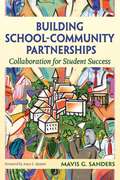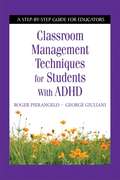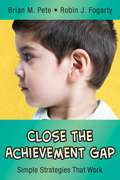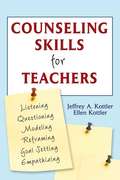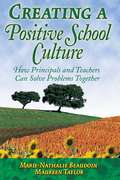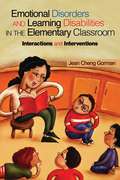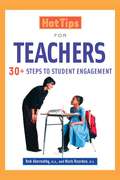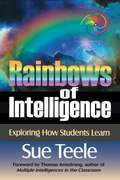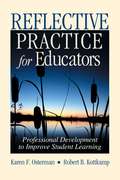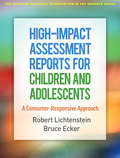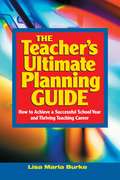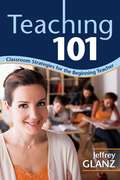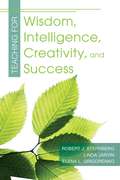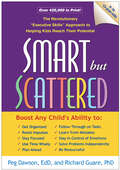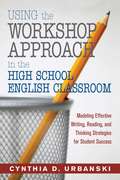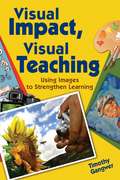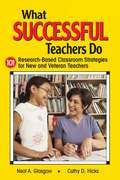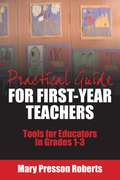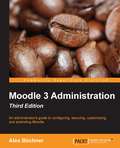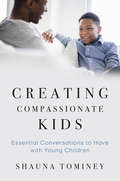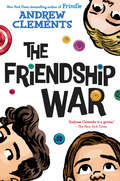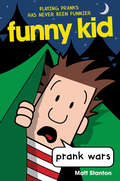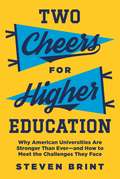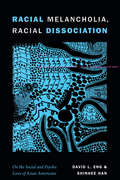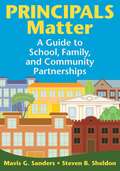- Table View
- List View
Building School-Community Partnerships: Collaboration for Student Success
by Mavis SandersThis current era of high stakes testing, accountability, and shrinking educational budgets demands that schools seek bold and innovative ways to build strong learning environments for all students. Community involvement is a powerful tool in generating resources that are essential for educational excellence. Building School-Community Partnerships: Collaboration for Student Success emphasizes the importance of community involvement for effective school functioning, student support and well-being, and community health and development. This sharp, insightful book serves as an excellent resource for educators seeking to establish school-community partnerships to achieve goals for their schools and the students, families, and communities they serve. Schools can collaborate with a wide variety of community partners to obtain the resources they need to achieve important goals for students’ learning. Some of these partners may include: - Businesses and corporations - Universities and other institutions of higher learning - National and local volunteer organizations - Social service agencies and health partners - Faith-based organizations and institutions Work successfully with community partners to improve school programs and curricula, strengthen families, and expand your students’ learning experiences!
Classroom Management Techniques for Students with ADHD: A Step-by-Step Guide for Educators (A\step-by-step Guide For Educators Ser.)
by Roger Pierangelo George GiulianiWorking with students who have been diagnosed with Attention Deficit Hyperactivity Disorder (ADHD) presents unique challenges for educators. This valuable resource provides general and special education professionals with an understanding of ADHD and appropriate strategies to help children participate in the classroom experience and develop to their fullest potential. Aligned with the reauthorization of IDEA 2004, Classroom Management Techniques for Students With ADHD presents practical, nuts-and-bolts methods and a concise glossary for teaching and working with this unique group of students. The authors, recognized experts in the field, succinctly cover: The characteristics of ADHD The processes and legal requirements for identifying students with ADHD Understanding different treatment options and how students are diagnosed Instructional techniques and behavioral interventions Classroom accommodations and modifications Use this indispensable text to help you work effectively with parents, other professionals, and the outside community in fostering successful learning experiences for students with ADHD.
Close the Achievement Gap: Simple Strategies That Work (In A Nutshell Ser.)
by Brian M. Pete Robin J. FogartyThis invaluable research-based guidebook illustrates how quality teaching can overcome the impact of low socioeconomic conditions and improve student performance dramatically. The authors present instructional techniques that require students to speak with skill, write with clarity and purpose, read with a critical eye, and listen with active engagement. Using six practical strategies, educators can overcome the odds and guide learners to success by: Setting high expectations for all students Making differentiation part of everything they do Challenging students to think critically Insisting on results-oriented goals
Counseling Skills for Teachers
by Jeffrey A. Kottler Ellen KottlerBy necessity, today's teachers do much more than deliver instruction. In the classroom, on the playground, or even in the parking lot, teachers are often called upon to respond quickly and appropriately to students' social and emotional needs, drawing from instinct more than anything else. In this second edition of the bestselling Counseling Skills for Teachers, Jeffrey and Ellen Kottler expertly guide preservice and inservice teachers to be effective helpers in the context of today's most common challenges, highlighting issues related to homelessness, grief and loss, and bullying and harassment. The book also discusses: - Responding to a range of behaviors in formal and informal school settings - Building a culture of tolerance and respect in the classroom - Motivating disengaged students - Communicating effectively with counseling professionals and parents With an entirely new chapter on "Counseling Yourself," the book offers teachers surefire techniques for taking better care of themselves and the students in their schools.
Creating a Positive School Culture: How Principals and Teachers Can Solve Problems Together
by Marie-Nathalie Beaudoin Maureen TaylorPrincipals and teachers have very different perspectives, pressures, and struggles. As a result, problems of negativity, isolation, or censure often develop among staff members. This may cause principals and teachers to spend a tremendous amount of energy addressing these issues instead of focusing on their primary goal—improved student achievement. Creating a Positive School Culture provides strategies for understanding and solving staff problems, preventing conflicts, and enriching school climates. By combining therapeutic knowledge with day-to-day educational experience, the authors offer innovative solutions for overcoming many energy- and morale-sapping problems, including gossip, cliques, negativity, and competition. To help engage and inspire readers, this volume includes: - Teacher and principal interview excerpts - Concise case examples of school culture problems - Step-by-step guidance for school culture interventions - Best practices culled from the authors’ extensive research - Ready-to-use tools, including school culture surveys and staff development exercises Based on more than 200 surveys and interviews with principals and teachers, this practical guidebook clearly explains how administrators, teachers, parents, and staff can all work together to solve problems and build a culture of caring and respect.
Emotional Disorders and Learning Disabilities in the Classroom: Interactions and Interventions
by Jean Cheng GormanThis unique book focuses on the interaction of learning disabilities and emotional disorders, fostering an understanding of how learning problems affect emotional well-being, and vice-versa. Jean Cheng Gorman provides research-based, classroom-tested practical interventions teachers can integrate into their daily routines, to help students become more purposeful and more effective. This book serves as a resource and a practical classroom guide for all elementary school teachers who are presented with the challenges of addressing the multiple needs - academic, emotional and social - of children with learning disabilities and emotional problems. Part I presents an overview of common learning disabilities and emotional problems. What disorders are teachers most likely to encounter? When should educators intervene, and when should they seek help from others? Part II offers specific classroom interactions and interventions, including insights on how: - Learning disorders are associated with emotional problems - Emotional problems can hide learning disabilities - Learning disorders can exacerbate emotional conditions - Emotional problems can intensify learning disabilities - Emotional health enhances learning . . . and each chapters includes tangible steps teachers can take in their classroom, as well as reproducibles that can be used as is, or as a starting point for materials development. The book ends with a rich and up-to-date list of additional resources for teachers and an annotated bibliography of children’s books and materials. Elementary teachers, administrators, and professional development directors can use this unique and comprehensive book as a solid foundation of knowledge and a practical resource for intervention.
Hot Tips for Teachers: 30+ Steps to Student Engagement
by Rob Abernathy Mark ReardonThese teaching tips help educators grab and maintain students’ attention through engaging presentation techniques for tone of voice, body language, pacing, and graphic displays. Each tip includes an explanation of the strategy, an activity to help readers integrate the skill into their repertoire, a learning strategy, and a self-reflection prompt.
Rainbows of Intelligence: Exploring How Students Learn
by Sue TeeleThis book explores the multiple ways students process information and examines multiple intelligences through the relationship between rainbows, colors, and how individuals learn. If we consider the full range of human potential as the spectrum of the rainbow, then each individual is unique and has the potential to develop all of the intelligences using different areas of the brain. The author has included several lesson plans that can be adapted for students of any age, and has written them to meet U. S. and California standards. This book will be a valuable resource for educators and administrators, school boards, and parents.
Reflective Practice for Educators: Professional Development to Improve Student Learning
by Karen F. Osterman Robert B. KottkampWritten for teachers, administrators, and professional development specialists in schools and universities, this book is an educators’ guide to reflective practice. In clear, accessible language, the authors explain the potential to create meaningful change in schools and show you how to integrate reflective practice effectively into the daily work of schools. The book: - Explains reflective practice as a professional development strategy and its importance for school reform - Offers ideas and practical strategies to facilitate collaborative, data-based inquiry, dialogue, and problem-solving in schools - Describes reflective practice in action and illustrates its power to create meaningful change in classrooms - Shows how reflective practice is an important step in creating professional learning organizations Reflective practice has the potential to renew your sense of optimism, commitment, and efficacy as you learn how to support meaningful professional growth, shape a culture of learning, and make important changes in students’ learning.
High-Impact Assessment Reports for Children and Adolescents: A Consumer-Responsive Approach (The Guilford Practical Intervention in the Schools Series)
by Robert Lichtenstein Bruce EckerAssessment provides rich opportunities for understanding the needs of children and adolescents, yet reports are often hard for parents, teachers, and other consumers to comprehend and utilize. This book provides step-by-step guidelines for creating psychoeducational and psychological reports that communicate findings clearly, promote collaboration, and maximize impact. Effective practices for written and oral reporting are presented, including what assessment data to emphasize, how to organize reports and convey test results, and how to craft useful recommendations. In a large-size format with lay-flat binding for easy photocopying, the book includes sample reports, training exercises, and reproducible templates, rubrics, and forms. Purchasers get access to a Web page where they can download and print the reproducible materials. This book is in The Guilford Practical Intervention in the Schools Series, edited by T. Chris Riley-Tillman.
The Teacher's Ultimate Planning Guide: How to Achieve a Successful School Year and Thriving Teaching Career
by Lisa Maria BurkeHigh levels of stress are an occupational hazard of the teaching profession, resulting from inadequate training for the broad scope of teacher responsibilities that extend beyond instruction. This comprehensive guide masterfully fills this void by creating a step-by-step sequence of practical techniques--based on research on successful teaching, and grounded in real-life examples--guiding teachers toward an effective action plan for successful teaching and classroom management. The manual’s concrete suggestions give teachers the skills and tactics they need to manage, control, and enrich their professional lives, with positive impacts and successes following beyond the classroom as well. Tackling major issues from designing effective lesson plans to maximizing limited resources, each chapter of this well-organized book begins with stated objectives and ends with a concise summary, making it easy to read, understand, and implement. It features a myriad of helpful hints that are invaluable in planning for the expected and the unexpected in the classroom, and in invigorating overall performance. Key value-added elements are: 13 easy-to-use resources, including lesson planning worksheets, calendar organizers, a substitute teacher kit, parent-teacher conferences reference, and a listing of professional organizations "Success Tips" sections throughout that highlight proven methods for working efficiently and effectively "True Stories" that punctuate and reinforce the techniques outlined Targeted questions in each chapter that encourage personalized reflection and solutions
Teaching 101: Classroom Strategies for the Beginning Teacher
by Jeffrey GlanzThe noble profession of teaching plays a vital role in inspiring students to achieve excellence. This new edition of one of the most comprehensive introductions to teaching available provides essential knowledge and actively engages new teachers in practice to become an exceptional teacher. Easy to understand and practical, this wide-ranging guide provides tools such as questions and activities at the end of each chapter, Web sites and vital readings for further study, and a self-assessment instrument to help readers succeed in their first year. The second edition includes more information on curriculum development and technology, more sample lesson plans, a new section on bullying, new activity sheets, and many checklists with immediate application procedures. The book is packed with helpful suggestions on topics such as: Lesson planning Classroom management Differentiating instruction Standards Assessment and grading Literacy Cooperative learning Inclusion National Board certification Teaching 101 is an invaluable resource that teachers can reference throughout their careers to expand their skills and perspectives.
Teaching for Wisdom Intelligence Creativity and Success
by Linda Jarvin Robert Sternberg Elena GrigorenkoThe essential guide for teaching beyond the test! Students with strong higher-order thinking skills are more likely to become successful, lifelong learners. Based on extensive, collaborative research by leading authorities in the field, this book shows how to implement teaching and learning strategies that nurture intelligence, creativity, and wisdom. This practical teaching manual offers an overview of the WICS model--Wisdom, Intelligence, Creativity, Synthesized--which helps teachers foster students' capacities for effective learning and problem solving. Teachers will find examples for language arts, history, mathematics, and science in Grades K-12, as well as: Hands-on strategies for enhancing students' memory, analytical, creative, and practical skills Guidelines on teaching and assessing for successful intelligence Details on how to apply the model in the classroom Teacher reflection sections, suggested readings, and sample planning checklists Teaching for Wisdom, Intelligence, Creativity, and Success is ideal for educators seeking to broaden their teaching repertoire as they expand the skills and abilities of students at all levels.
Smart but Scattered: The Revolutionary "Executive Skills" Approach to Helping Kids Reach Their Potential
by Peg Dawson Richard GuareThere's nothing more frustrating than watching your bright, talented son or daughter struggle with everyday tasks like finishing homework, putting away toys, or following instructions at school. Your "smart but scattered" child might also have trouble coping with disappointment or managing anger. Drs. Peg Dawson and Richard Guare have great news there's a lot you can do to help. The latest research in child development shows that many kids who have the brain and heart to succeed lack or lag behind in crucial "executive skills"--the fundamental habits of mind required for getting organized, staying focused, and controlling impulses and emotions. Learn easy-to-follow steps to identify your child's strengths and weaknesses, use activities and techniques proven to boost specific skills, and problem-solve daily routines. Small changes can add up to big improvements--this empowering book shows how.
Using the Workshop Approach in the High School English Classroom: Modeling Effective Writing, Reading, and Thinking Strategies for Student Success
by Cynthia D. UrbanskiDo you find that preparing for standardized tests interferes with teaching advanced thinking, reading, and writing skills in a meaningful way? Do you want to balance test preparation with more creative activities? Success in school and beyond depends on one’s ability to read fluently, write coherently, and think critically. This handbook uses the workshop model for exponentially increasing adolescents’ abilities in these three key areas. This practical guide addresses the daily running and practice of a workshop-based classroom, using research and the author’s own experiences to illustrate how to establish a workshop that: Fosters lasting learning while reinforcing the skills needed for standardized tests Teaches audience and purpose as a vehicle to style and structure Provides a supportive and lively environment in which students are comfortable enough to take risks and share original ideas Try Urbanski’s approach to teaching literacy analysis and mentoring student writers, and discover just how rewarding the workshop experience can be!
Visual Impact, Visual Teaching: Using Images to Strengthen Learning
by Timothy GangwerEach day, teachers look for new ways to get students excited about learning and new ways to help them retain the information they learn. In this practical guide, Timothy Gangwer incorporates the latest research on visual learning and shows how you can stimulate students' interest and participation. Offering classroom-tested techniques to engage learners' brains, this book includes hundreds of ready-to-use visual learning activities in language arts, math, science, social studies, environmental studies, the arts, and more. This resource covers: Differentiating instruction based on how students process visual information Using graphic organizers, digital photography, the Internet, and other visual communication tools Incorporating music, art, and drama to enhance instruction and learning Teaching visual communication strategies to English language learners Discover how to use visual strategies and activities to help students think critically about the way they understand and perceive the world.
What Successful Teachers Do: 101 Research-Based Classroom Strategies for New and Veteran Teachers (1-off Ser.)
by Neal A. Glasgow Cathy D. HicksWritten for novice and seasoned professionals alike, this updated edition of a powerful bestseller provides research-based best practices and practical applications that promote strong instruction and classroom management. The authors translate the latest research into 101 effective strategies for new and veteran K-12 teachers. Updated throughout, and with an entirely new chapter on supporting reading and literacy, this edition presents the strategies in a user-friendly format: The Strategy: a concise statement of an instructional strategy What the Research Says: a brief discussion of the research to provide readers with a deeper understanding of the principles involved Classroom Application: how each strategy can be used in instructional settings Precautions and Possible Pitfalls: caveats to help teachers avoid common problems Sources: a reference list for further reading What Successful Teachers Do is a valuable resource for strengthening teachers' professional development and improving student performance.
Practical Guide for First-Year Teachers: Tools for Educators in Grades 1-3
by Mary Presson RobertsMary Presson Roberts remembers her first year of teaching fourteen years ago and the less than positive experience she had to overcome as she struggled alone to become the dedicated and excellent teacher she is today. Your Mentor: A Practical Guide for First-Year Teachers in Grades 1-3 is Roberts’ way of making sure other new teachers have the support they need when they need it. This practical, easy-to-implement guide was developed by surveying student teachers, substitute teachers, returning teachers, emergency credential teachers, and teacher educators. Their wide-ranging responses to what they wanted to see included in a teaching reference covered setting up a classroom, developing themes, instructional presentation, student assessment, parent communications, field trips, and more. Your Mentor was written as a stand-alone reference guide when no other support is available or as a supplement to existing school support programs. Actual samples of lesson units, themes, and communications with parents are included along with easy-to-follow, classroom-tested suggestions for: - Lesson plans - Record keeping - Using technology in the classroom - Planning special events - Developing and maintaining professional credentials and portfolios This book will be a valuable reference tool for those in their first few years of teaching, teachers returning to the classroom, and students considering the teaching profession. It will serve as daily companion--like the experienced teacher we all want and need.
Moodle 2.7 LTS Administration - Third Edition
by Alex BuchnerThe book takes a problem-solution approach to fall in line with your day-to-day operations. This is a one-stop reference for any task you will ever come across when administering a Moodle site of any shape and size. If you are a technician, systems administrator, or part of academic staff, this is the book for you. This book is ideal for anyone who has to administer a Moodle system. Whether you are dealing with a small-scale local Moodle system or a large-scale multi-site Virtual Learning Environment, this book will assist you with any administrative task. Some basic Moodle knowledge is helpful, but not essential.
Creating Compassionate Kids: 50 Essential Conversations To Have With Young Children
by Shauna TomineyYoung children can surprise us with tough questions. Tominey’s essential guide teaches us how to answer them and foster compassion along the way. If you had to choose one word to describe the world you want children to grow up in, what would it be? Safe? Understanding? Resilient? Compassionate? As parents and caregivers of young children, we know what we want for our children, but not always how to get there. Many children today are stressed by academic demands, anxious about relationships at school, confused by messages they hear in the media, and overwhelmed by challenges at home. Young children look to the adults in their lives for everything. Sometimes we’re prepared... sometimes we’re not. In this book, Shauna Tominey guides parents and caregivers through how to have conversations with young children about a range of topics-from what makes us who we are (e.g., race, gender) to tackling challenges (e.g., peer pressure, divorce, stress) to showing compassion (e.g., making friends, recognizing privilege, being a helper). Talking through these topics in an age-appropriate manner—rather than telling children they are too young to understand—helps children recognize how they feel and how they fit in with the world around them. This book provides sample conversations, discussion prompts, storybook recommendations, and family activities. Dr. Tominey's research-based strategies and practical advice creates dialogues that teach self-esteem, resilience, and empathy: the building blocks for a more compassionate world.
The Friendship War
by Andrew ClementsStickers, Silly Bandz, Rainbow Looms, fidget spinners . . . buttons?! A brand-new school story about friendship and fads from the bestselling author of Frindle. <P><P>This is war. Okay--that's too dramatic. But no matter what this is called, so far I'm winning. <P><P>And it feels wonderful. <P><P>Grace and Ellie have been best friends since second grade. Ellie's always right in the center of everything--and Grace is usually happy to be Ellie's sidekick. But what happens when everything changes? <P><P>This time it's Grace who suddenly has everyone's attention when she accidentally starts a new fad at school. It's a fad that has first her class, then her grade, and then the entire school collecting and trading and even fighting over . . . buttons?! <P><P>A fad that might also get her in major trouble and could even be the end of Grace and Ellie's friendship. Because Ellie's not used to being one-upped by anybody. There's only one thing for Grace to do. With the help of Hank--the biggest button collector in the sixth grade--she will have to figure out a way to end the fad once and for all. But once a fad starts, can it be stopped? <P><P>Andrew Clements, the beloved author of Frindle, returns with a deliciously entertaining and deeply satisfying story that will resonate with anyone who's ever been in a classroom . . . or been a kid. A fad is a tough thing to kill, but then again, so is a friendship.
Funny Kid #3: Prank Wars (Funny Kid #3)
by Matt StantonBig Nate meets Timmy Failure in Funny Kid #3: Prank War, the third book in the uproarious highly illustrated middle grade series by Matt Stanton, Australia’s bestselling children’s book author.Max is the Funny Kid and, given the choice, he’d always rather laugh than fight. But when a prank war breaks out just before the big overnight class trip, Max has no choice but to pull off the funniest prank ever! Gunker dragons, duck smugglings, stolen suitcases, lethal super-beans, and the greatest prank ever played are just some of the hilarious antics in store. Paired with hilarious black-and-white illustrations from the author, Max’s mishaps will leave even the most reluctant reader laughing out loud. Matt Stanton again brings his bestselling children’s book chops to the hilarious Funny Kid series, perfect for early middle grade readers looking for side-splitting laughs and lovable, relatable characters!
Two Cheers for Higher Education: Why American Universities Are Stronger Than Ever—and How to Meet the Challenges They Face (The William G. Bowen Series #112)
by Steven BrintA leading expert challenges the prevailing gloomy outlook on higher education with solid evidence of its successesCrushing student debt, rapidly eroding state funding, faculty embroiled in speech controversies, a higher-education market disrupted by online competition—today’s headlines suggest that universities’ power to advance knowledge and shape American society is rapidly declining. But Steven Brint, a renowned analyst of academic institutions, has tracked numerous trends demonstrating their vitality. After a recent period that witnessed soaring student enrollment and ample research funding, universities, he argues, are in a better position than ever before.Focusing on the years 1980–2015, Brint details the trajectory of American universities, which was influenced by evolving standards of disciplinary professionalism, market-driven partnerships (especially with scientific and technological innovators outside the academy), and the goal of social inclusion. Conflicts arose: academic entrepreneurs, for example, flouted their campus responsibilities, and departments faced backlash over the hiring of scholars with nontraditional research agendas. Nevertheless, educators’ commitments to technological innovation and social diversity prevailed and created a new dynamism.Brint documents these successes along with the challenges that result from rapid change. Today, knowledge-driven industries generate almost half of U.S. GDP, but divisions by educational level split the American political order. Students flock increasingly to fields connected to the power centers of American life and steer away from the liberal arts. And opportunities for economic mobility are expanding even as academic expectations decline.In describing how universities can meet such challenges head on, especially in improving classroom learning, Brint offers not only a clear-eyed perspective on the current state of American higher education but also a pragmatically optimistic vision for the future.
Racial Melancholia, Racial Dissociation: On the Social and Psychic Lives of Asian Americans
by David L. Eng Shinhee HanIn Racial Melancholia, Racial Dissociation critic David L. Eng and psychotherapist Shinhee Han draw on case histories from the mid-1990s to the present to explore the social and psychic predicaments of Asian American young adults from Generation X to Generation Y. Combining critical race theory with several strands of psychoanalytic thought, they develop the concepts of racial melancholia and racial dissociation to investigate changing processes of loss associated with immigration, displacement, diaspora, and assimilation. These case studies of first- and second-generation Asian Americans deal with a range of difficulties, from depression, suicide, and the politics of coming out to broader issues of the model minority stereotype, transnational adoption, parachute children, colorblind discourses in the United States, and the rise of Asia under globalization. Throughout, Eng and Han link psychoanalysis to larger structural and historical phenomena, illuminating how the study of psychic processes of individuals can inform investigations of race, sexuality, and immigration while creating a more sustained conversation about the social lives of Asian Americans and Asians in the diaspora.
Principals Matter: A Guide to School, Family, and Community Partnerships
by Mavis G. Sanders Steven B. SheldonResearch has shown that strong principal leadership is critical to developing effective school partnerships that include diverse school, family and community members. This book provides administrators with a clear road map for initiating partnership programs that are goal-focused, equitable, and sustainable.In this research-based resource, the authors highlight the work of principals who have cultivated successful partnerships across many settings to show other school leaders how they can develop the necessary supportive school cultures. Examining the administrator's role in the success and quality of home-school partnerships and student outcomes, this guidebook: Synthesizes research on principal leadership, school and community partnerships, and urban education reform Discusses the role of fathers in children’s learning and working with families that live in poverty, are linguistically diverse, or have children with disabilities Offers practical recommendations for evaluating and refining partnership programs to ensure they are linked with student achievement goals
